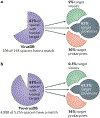CRISPR-Cas in mobile genetic elements: counter-defence and beyond
- PMID: 31165781
- PMCID: PMC11165670
- DOI: 10.1038/s41579-019-0204-7
CRISPR-Cas in mobile genetic elements: counter-defence and beyond
Abstract
The principal function of CRISPR-Cas systems in archaea and bacteria is defence against mobile genetic elements (MGEs), including viruses, plasmids and transposons. However, the relationships between CRISPR-Cas and MGEs are far more complex. Several classes of MGE contributed to the origin and evolution of CRISPR-Cas, and, conversely, CRISPR-Cas systems and their components were recruited by various MGEs for functions that remain largely uncharacterized. In this Analysis article, we investigate and substantially expand the range of CRISPR-Cas components carried by MGEs. Three groups of Tn7-like transposable elements encode 'minimal' type I CRISPR-Cas derivatives capable of target recognition but not cleavage, and another group encodes an inactivated type V variant. These partially inactivated CRISPR-Cas variants might mediate guide RNA-dependent integration of the respective transposons. Numerous plasmids and some prophages encode type IV systems, with similar predicted properties, that appear to contribute to competition among plasmids and between plasmids and viruses. Many prokaryotic viruses also carry CRISPR mini-arrays, some of which recognize other viruses and are implicated in inter-virus conflicts, and solitary repeat units, which could inhibit host CRISPR-Cas systems.
Figures






References
-
- Mohanraju P. et al. Diverse evolutionary roots and mechanistic variations of the CRISPR-Cas systems. Science 353, aad5147 (2016). - PubMed
-
- Barrangou R & Horvath P A decade of discovery: CRISPR functions and applications. Nat. Microbiol 2, 17092 (2017). - PubMed
-
- Jackson SA et al. CRISPR-Cas: adapting to change. Science 356, eaal5056 (2017). - PubMed
-
-
Koonin EV, Makarova KS & Zhang F Diversity, classification and evolution of CRISPR-Cas systems. Curr. Opin. Microbiol 37, 67–78 (2017).
This article is the latest published overview of the CRISPR–Cas diversity, with an emphasis on Class 2 systems discovered through dedicated search efforts.
-
Publication types
MeSH terms
Substances
Grants and funding
LinkOut - more resources
Full Text Sources
Other Literature Sources

